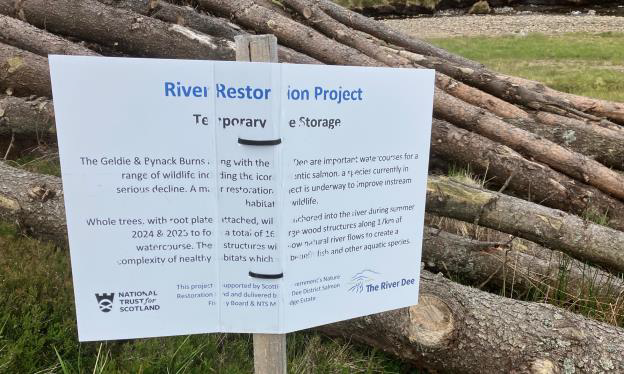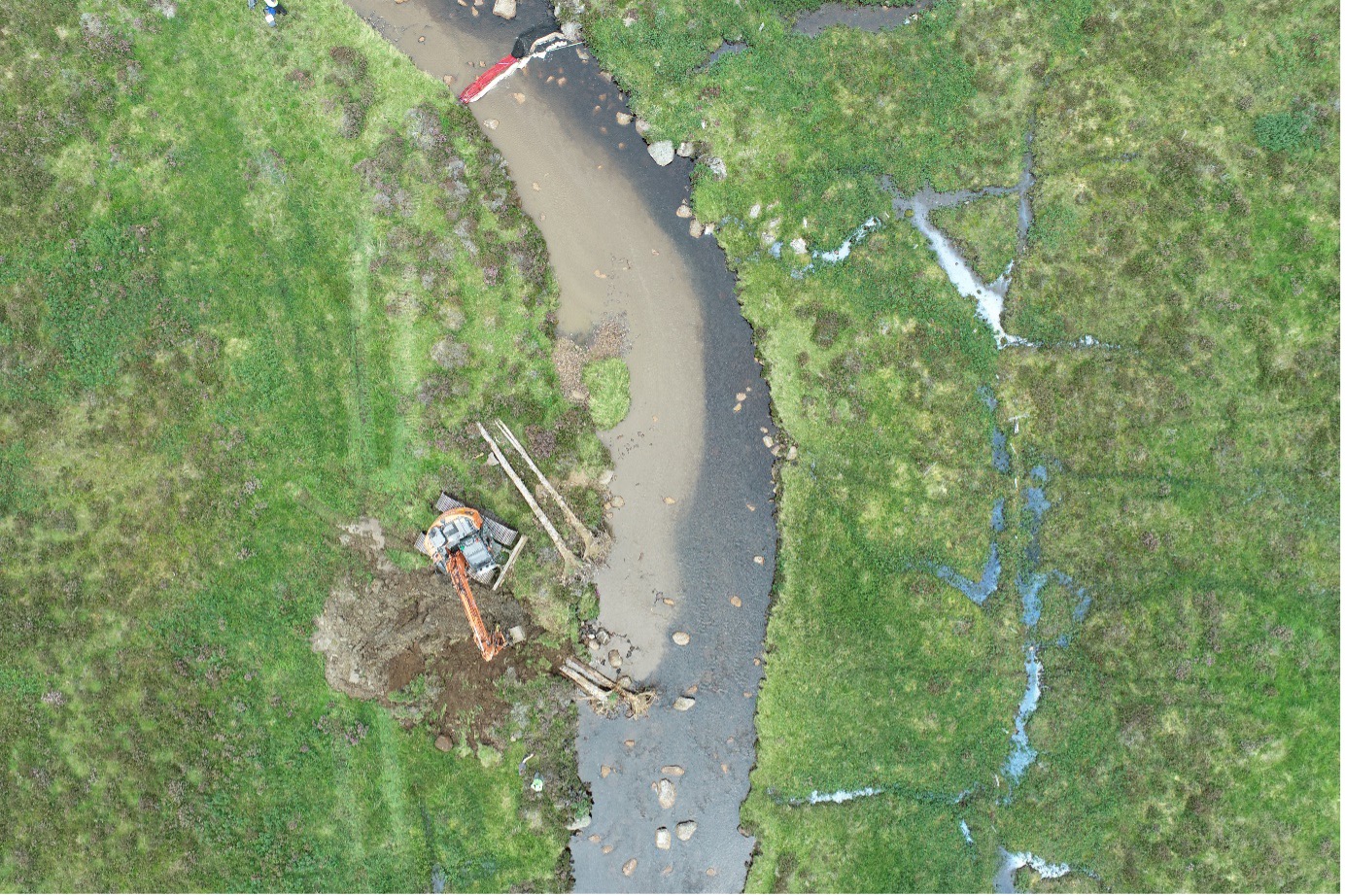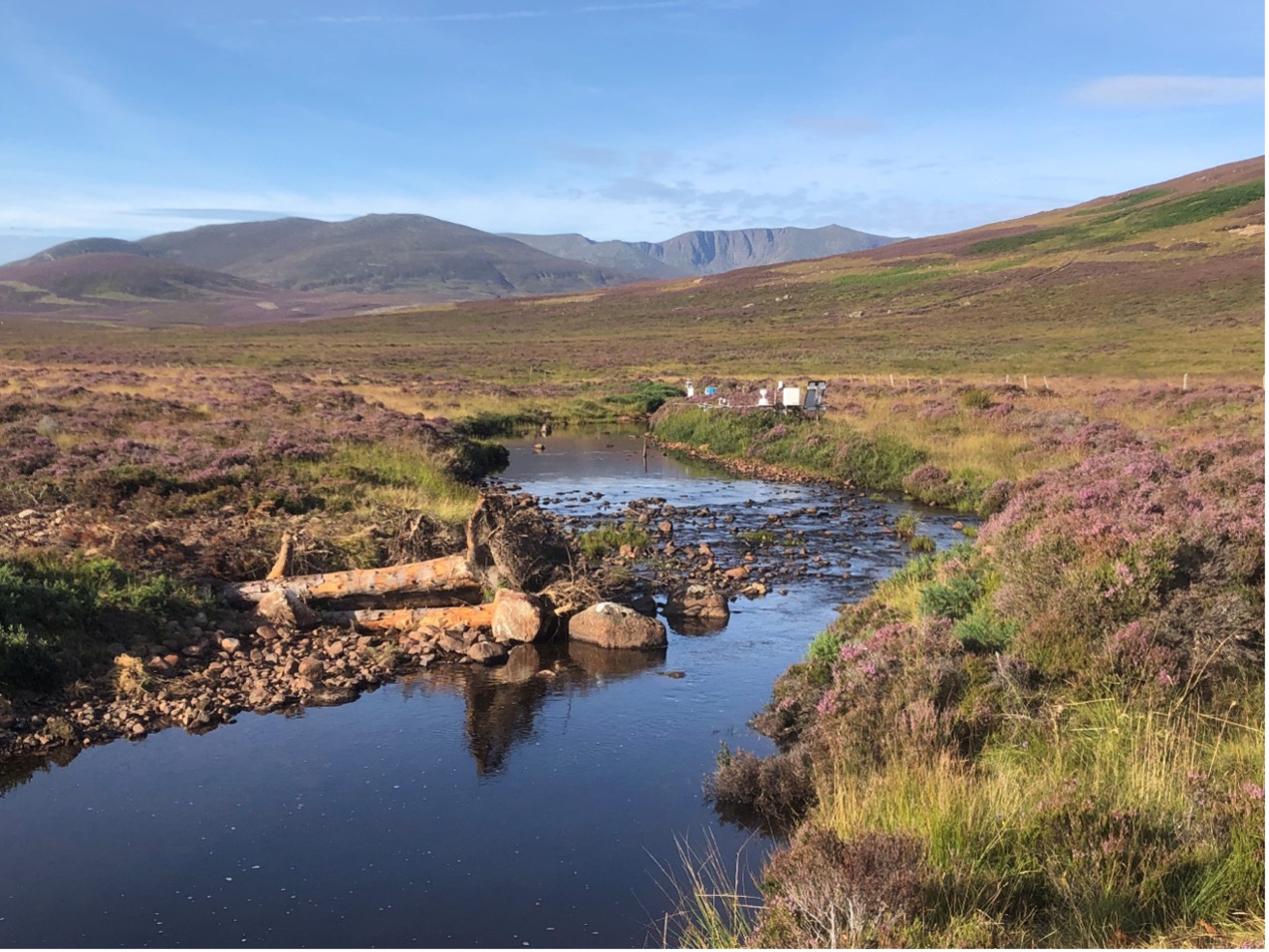
En route to Carn Ealar © C Lacy
 |
En route to Carn Ealar © C Lacy |

A drone image of a digger installing a Large Wood Structure in a Cairngorm stream. The sediment pollution is likely to cause mortalities of juvenile salmon and siltation of habitats downstream. The ineffectiveness of the sediment management structure in the upper photo is evident. Up to 100 such structures might be installed over a few miles of river length.
Over recent years, significant public funds became available for restoration work to address the climate and biodiversity crises. The Scottish Government established the Nature Restoration Fund (NRF) to resource such work. This has been used to fund numerous projects based on "restoring" rivers for salmon. Rivers like the Spey, Tay and Dee all have Cairngorms headwaters, and are famous for their salmon fishing which is important for local jobs, economic income and culture. Given that these rivers have provided good habitat for salmon over much of the last century, itīs reasonable to ask why they suddenly need "restoring"?
Unfortunately, these rivers have seen catastrophic declines in salmon populations in recent decades. Scientific evidence points to climate change in the Atlantic Ocean adversely affecting the feeding grounds of salmon in the marine phase of their life cycle, leading to poor survival and reduced numbers of adult fish returning to rivers to breed. This marine problem is a complex challenge that is difficult to address. Consequently, some fisheries managers, NGOs and landowners have decided to focus on "restoring" rivers to enhance salmon habitats in the hope that this helps.
This is where river engineering comes in. A major component of such schemes is the installation of so-called Large Wood Structures (LWS) to diversify salmon habitat. These structures involve the trunk and root plate of dead wind-blown trees. These are "fixed" into the bed and banks of streams by excavating large holes with diggers, then back-filling with large boulders so that the structures do not move. These vary in size, but the largest ones can include 6 trees and cost up to Ģ4K each to install. Hundreds of these structures have been engineered into Cairngorms rivers, with hundreds more planned. In some schemes ~100 LWSs have been installed over a few miles of river length, and they become a very dominant feature of the riverscape.
How is this "restoration"? The reasoning of proponents of such schemes is that LWSs alter patterns of erosion and deposition, diversifying habitat and creating cover that benefit salmon. Moreover, it is further argued that these features would have occurred back in the days when river corridors would have been more forested, and trees would have fallen into the river diversifying habitat. As riparian planting is usually also part of these schemes, it is argued that the engineering helps kick-start "restoration" in ways that will benefit salmon.
The major problem is that there is no strong scientific evidence that these costly interventions will enhance salmon populations. Salmon thrived in Cairngorms rivers in the early 20th century when tree cover was lower than it is today. There is no evidence that suitable habitat is a limiting factor on salmon populations in most Cairngorms rivers. Rather, the main cause is poor marine survival, causing a downward spiral of salmon populations.

Salmon habitat "restoration" using a Large Wood Structure comprising 6 trees. Salmon have been known to spawn at the riffle in the centre of the photo for the past 60 years, yet it is now potentially compromised by the engineered structure; the installation of which involved compaction of the riffle by heavy machinery. Protection - not disturbance - of pre-existing habitat is usually a fundamental principle of nature conservation.
Even worse, in addition to being ineffective, in many cases installation of LWS involves actually degrading pre-existing salmon habitat. Moreover, installation can result in fine sediment plumes that can cause salmon mortalities and degrade downstream habitat through siltation. This is in addition to the compaction of stream sediments and damage to sensitive riparian areas that the activities of 16-tonne diggers can cause when trundling through river corridors.
So why are such inappropriate and ineffective engineering techniques suddenly being applied in Cairngorms rivers? Up until a few years ago, virtually all river restoration schemes in the UK were small scale - typically under a mile of river - and restricted to heavily managed urban or agricultural streams. In these cases, judicious use of LWSs can help diversity heavily degraded river channels. Such use has been encouraged by the Scottish Environment Protection Agency (SEPA) whose guidance allows the use of wood structures without the licensing and assessment usually required for river engineering. However, this creates a loophole where large wood can be used instead of concrete or boulder rip-rap in multiple engineered structures such as croys, deflectors and other structures. This loophole, and the availability of public resources like the NRF, has led to the rapid upscaling of schemes now affecting over 100km of Cairngorms rivers in schemes where the need for "restoration" has rarely been established in any scientifically meaningful way.
We might expect that the conservation designations that apply in the Cairngorms would ensure that rivers are protected from such gratuitous and potentially damaging engineering. Ironically, however, some of these schemes have been funded and approved by NatureScot, who have acknowledged to the author the likely ineffectiveness of LWSs in facilitating any enhancement of salmon populations, but claim that such schemes have wider (undefined) biodiversity benefits. Scottish Government policy sees such schemes as helping to fuel the rural economy by providing funding for landowners, conservation organisations and contractors. Meantime, as virtually no schemes have any scientifically robust monitoring requirements to assess their effectiveness, once the diggers leave the site, the project can be triumphantly declared as "delivered" and the river "restored" as they move on to the next project.
Clearly there is much momentum in re-wilding and restoration in the uplands, and many projects have the potential to deliver significant benefits to nature. However, as the current rash of engineering schemes on Cairngorms rivers shows, the assumptions behind such schemes need to be carefully evaluated and their likely effectiveness and potential for adverse impacts properly assessed. This requires effective, evidence-based environmental regulation which is currently lacking. Without this, we will continue to see large sums of public money being wasted on inappropriate engineering of upland streams through structures - which although made of wood - will persist for many decades. And, despite this creation of highly un-natural and "de-wilded" riverscapes, salmon populations will likely continue to decline.
Chris Soulsby is Professor of Hydrology in the School of Geosciences at the University of Aberdeen. He has over three decades of experience of research on the hydrology and ecology of rivers in the Cairngorms. He has published over 400 papers in the international scientific literature and is a Fellow of the Royal Society of Edinburgh.
Please let the webmaster know if there are problems with viewing these pages or with the links they contain.